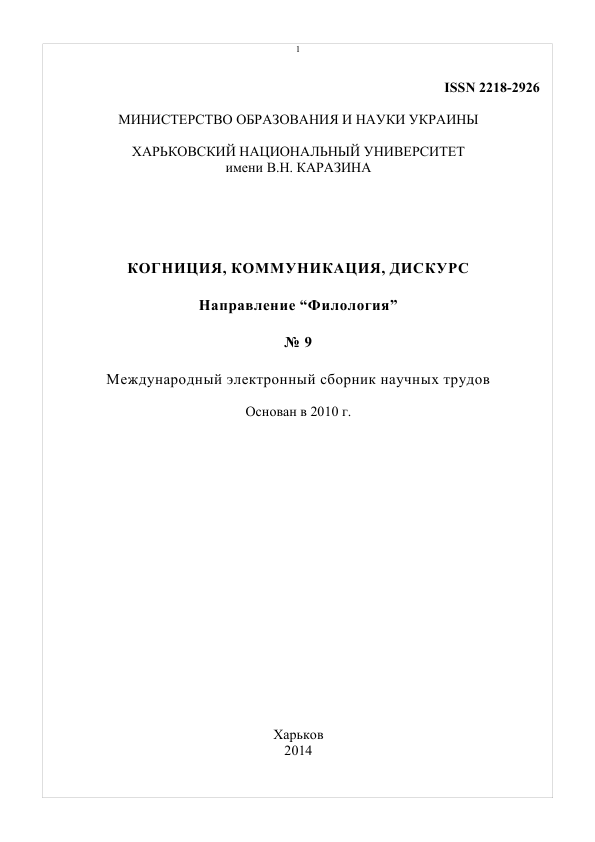Концепції перекладацької творчості
Анотація
Перекладацька творчість представлена як дуалістичний антропогенний феномен, який об’єднує діяльність зі створення нового продукту та сам цей продукт, представлений в одиницях мовної ієрархії та мовленнєвих творах – текстах. На основі принципу онтологічного релятивізму виокремлено головні онтології перекладу та відповідні їм концепції перекладацької творчості – мовоцентричну, текстоцентричну та діяльнісноцентричну.
Завантаження
Посилання
Benjamin, W. (2000). The Task of the Translator. An Introduction to the Translation of Baudelaire’s Tableaux Parisiens. In: L. Venuti (ed.). The Translation Studies Reader. London and New York: Routledge, pp.148-159.
Bernardini, S. (2001). Using Think-Aloud Protocols to Investigate the Translation Process: Methodological Aspects. Target, 13(2), 241-63.
Biguenet, J., and Schulte, R. (1989). The Craft of Translation. Chicago: University of Chicago Press.
Britannica Concise Encyclopedia. Available at: http://www.britannica.com/.
Bіlodіd, І. K., Buriachok, A. A., Vynnyk, V. O., Hnatiuk, H.M. et al. (Eds.) (1979). Slovnyk ukrainskoi movy [A dictionary of the Ukrainian language] (Vol. 10). Kyiv: Naukova dumka Publ. (in Ukrainian)
Cronin, M. (1995). Keeping One’s Distance: Translation and the Play of Possibility. TTR: traduction, terminologie, redaction, 8(2), 227-243.
Eco, U. (1894). The Role of the Reader. Bloomington: Indiana University Press. Fedorov, A.V. (2002). Osnovy obshhej teorii perevoda (lingvisticheskie problemy) [Basics of the general theory of translation (linguistic issues)] (5 th ed.). Saint Petersburg.: SPbU Faculty of Philology Publ., Moscow: FILOLOGIJA TRI Publ. (in Russian)
Guilford, J. P. (1967). The Nature of Human Intelligence. N.Y.: McGraw-Hill. Hermans, T. (1996). Norms and the Determination of Translation. In: R. Alvarez and M. Vidal (eds). Translation, Power, Subversion. Clevedon: Multilingual Matters, pp. 25-51.
Jakobson, R. (1981). Poetry of Grammar and Grammar of Poetry (Vol.3). The Hague: Mouton.
Kerr B. Encyclopedia of Giftedness, Creativity, and Talent. Available at: http://knowledge.sagepub.com/view/giftedness/n166.xml.
Komissarov, V.N. (1999). Perevodovedenie v XX veke: nekotorye itogi [Translation studies in the 20 th century: some results]. Tetradi perevodchika – Translator’s Notes, 24, 4-20. (in Russian)
Kussmaul, P., and Tirkkonen-Condit, S. (1995). Think-Aloud Protocol Analysis. Translation Studies TTR: traduction, terminologie, redaction, 8(1), 177–199.
Lefevere, A. (1992). Translation, Rewriting and the Manipulation of Literary Fame. London and New York: Routledge.
Lefevere, A. (2000). Mother Courage’s Cucumbers. Text, System and Refraction in a Theory of Literature. In: L. Venuti (ed.). The Translation Studies Reader. London and New York: Routledge, pp.233-249.
Loffredo, E., and Perteghella, M. (2007). Introduction. In: E. Loffredo and M. Perteghella (eds.). Translation and Creativity: Perspectives on Creative Writing and Translation Studies. London: Continuum, pp. 1-16.
Martyniuk, A.P. (2012). Slovnyk osnovnykh termіnіv kohnіtyvno-dyskursyvnoi lіnhvіstyky [Dictionary of basic terms of cognitive-discursive linguistics] Kharkіv: V. N. Karazіn KhNU Publ. (in Ukrainian)
Nikolaou, P. (2007). Notes on Translating the Self. In: E. Loffredo and M. Perteghella (eds.). Translation and Creativity: Perspectives on Creative Writing and Translation Studies. London: Continuum, pp. 19-32.
Norman, D.A., and Bobrow, D.G. (1975). On Data-limited and Resource-limited Processes. Cognitive Psychology, 7, 44-64.
Paz, O. (1992). Translation: Literature and Letters. In: R. Schulte and J. Biguenet (eds.). Theories of Translation from Dryden to Derrida. Chicago: Chicago University Press, pp. 152-163.
Prigogine, M., and Patterson, T. (2006). The Scientist and Prigogine’s futur créateur. Dialectic. International Journal of Ecodynamics, 1(1). Available at: http://www.tristapatterson.com/pdfs/ PattersonAndPrigogine.pdf.
Quine, W.V. (1968). Ontological Relativity. The Journal of Philosophy, 65(7), 185-212.
Rebrii, O. (2013). Think-Aloud Protocols as a Means of Studying Cognitive Mechanisms of Translator’s Creativity. The Advanced Science: open access journal, 4, 11–14.
Riabtseva, N. Perevodovedenie v Rossii i za rubezhom. Ch. 2. Analiz jempiricheskogo materiala. [Translation studies in Russia and beyond. Part 2. A case study]. Available at: http://www.iling-ran.ru/Riabtseva2.doc.
Tarnaeva, L.P. (2010). Kreativnye mehanizmy rechevoj dejatel'nosti perevodchika: lingvodidakticheskij aspekt problemy [Creative mechanisms of the translator’s speech activity: linguistic and didactic aspects of the problem]. Vestnik Tverskogo gosudarstvennogo universiteta. Ser.: Pedagogika i psihologija – Herald of Tver State University. Pedagogy and Psychology Series, 35, 129-134. (in Russian)
Torrance, E.P. (1988). The nature of creativity as manifest in its testing. In: R.J. Sternberg (ed.). The nature of creativity. New York: Cambridge University Press, pp. 43-73.
Tsvilling, M.Ja. (1999). Perevodovedenie kak sintez znanija [Translation studies as knowledge synthesis]. Tetradi perevodchika – Translator’s Notes, 24, 32-37. (in Russian)
Zimnjaja, I.A. (2001). Lingvopsihologija rechevoj dejatel'nosti [Linguistic philosophy of speech activity]. Moscow: Moscow Psychological-Social Institute Publ.; Voronezh: NPO «MODJeK» Publ. (in Russian)
Автори, які публікуються у цьому журналі, погоджуються з наступними умовами:
Автори залишають за собою право на авторство своєї роботи та передають журналу право першої публікації цієї роботи на умовах ліцензії Creative Commons Attribution License (CC BY), яка дозволяє іншим особам вільно розповсюджувати опубліковану роботу з обов'язковим посиланням на авторів оригінальної роботи та першу публікацію роботи у цьому журналі.
Автори мають право укладати самостійні додаткові угоди щодо неексклюзивного розповсюдження роботи у тому вигляді, в якому вона була опублікована цим журналом (наприклад, розміщувати роботу в електронному сховищі установи або публікувати у складі монографії), за умови збереження посилання на першу публікацію роботи у цьому журналі.
Політика журналу дозволяє і заохочує розміщення авторами в мережі Інтернет (наприклад, у сховищах установ або на особистих веб-сайтах) рукопису роботи, як до подання цього рукопису до редакції, так і під час його редакційного опрацювання, оскільки це сприяє виникненню продуктивної наукової дискусії та позитивно позначається на оперативності та динаміці цитування опублікованої роботи (див. The Effect of Open Access).




